A strong signal from On Balance Volume adds confidence to the Elliott wave count.
Summary: A short term Elliott wave target is 2,744. A short term classic analysis target is 2,811. At about one of these points a small consolidation or pullback may be expected.
The long to mid term Elliott wave target is at 2,922, and a classic analysis target is now at 3,045.
Corrections are an opportunity to join the trend.
New all time highs this week, from both the AD line and On Balance Volume, give a high level of confidence to the expectation that price is likely to follow through to new all time highs.
Always practice good risk management. Always trade with stops and invest only 1-5% of equity on any one trade.
New updates to this analysis are in bold.
The biggest picture, Grand Super Cycle analysis, is here.
Last historic analysis with monthly charts is here. Video is here.
An alternate idea at the monthly chart level is given here at the end of this analysis.
An historic example of a cycle degree fifth wave is given at the end of the analysis here.
ELLIOTT WAVE COUNT
WEEKLY CHART
Cycle wave V must complete as a five structure, which should look clear at the weekly chart level. It may only be an impulse or ending diagonal. At this stage, it is clear it is an impulse.
Within cycle wave V, the third waves at all degrees may only subdivide as impulses.
Intermediate wave (4) has breached an Elliott channel drawn using Elliott’s first technique. The channel is redrawn using Elliott’s second technique: the first trend line from the ends of intermediate waves (2) to (4), then a parallel copy on the end of intermediate wave (3). Intermediate wave (5) may end either midway within the channel, or about the upper edge.
Intermediate wave (4) may now be a complete regular contracting triangle lasting fourteen weeks, one longer than a Fibonacci thirteen. There is perfect alternation and excellent proportion between intermediate waves (2) and (4).
If intermediate wave (4) were to continue further as either a flat or combination, both possibilities would require another deep pullback to end at or below 2,532.69. With both On Balance Volume and the AD line making a new all time highs this week, that possibility looks extremely unlikely.
If intermediate wave (4) were to continue further, it would now be grossly disproportionate to intermediate wave (2). Both classic technical analysis and Elliott wave analysis now suggest these alternate ideas should be discarded based upon a very low probability.
DAILY CHART
It is possible that intermediate wave (4) is a complete regular contracting triangle, the most common type of triangle. Minor wave E may have found support just above the 200 day moving average and ending reasonably short of the A-C trend line. This is the most common look for E waves of triangles.
Intermediate wave (3) exhibits no Fibonacci ratio to intermediate wave (1). It is more likely then that intermediate wave (5) may exhibit a Fibonacci ratio to either of intermediate waves (1) or (3). The most common Fibonacci ratio would be equality in length with intermediate wave (1), but in this instance that would expect a truncation. The next common Fibonacci ratio is used to calculate a target for intermediate wave (5) to end.
Price has clearly broken out above the upper triangle B-D trend line. This indicates that it should now be over if the triangle is correctly labelled.
A resistance line in lilac is added to this chart. It is the same line as the upper edge of the symmetrical triangle on the daily technical analysis chart. Upwards movement has sliced cleanly through this line, finding no resistance before breaking it. This line may offer some support for any pullbacks.
Sometimes the point at which the triangle trend lines cross over sees a trend change. A trend change at that point may be a minor one or a major one. That point is about the 3rd of June.
HOURLY CHART
Intermediate wave (5) must subdivide as either an impulse or an ending diagonal. An impulse is much more common and that shall be how this is labelled, until price shows otherwise.
So far minor wave 1 may be incomplete and subdividing as an impulse.
Within minor wave 1, minute waves i and ii may be complete. The target for minute wave iii expects only equality in length with minute wave i because minute wave ii was very shallow.
Minute wave iii may only subdivide as an impulse, and within it minuette waves (i), (ii), (iii) and (iv) may be complete. There is no Fibonacci ratio between minuette waves (i) and (iii), so it is more likely that minuette wave (v) may exhibit a Fibonacci ratio to either of minuette waves (i) or (iii). Equality in length with minuette wave (i) would be the most likely. The target is widened to a small zone calculated at two degrees.
Minuette wave (iv) may not move into minuette wave (i) price territory below 2,683.26.
A base channel is drawn about minute waves i and ii. Along the way up, corrections should find support about the lower edge of this channel. Minute wave iii may have the power to break above the upper edge of the base channel.
TECHNICAL ANALYSIS
WEEKLY CHART
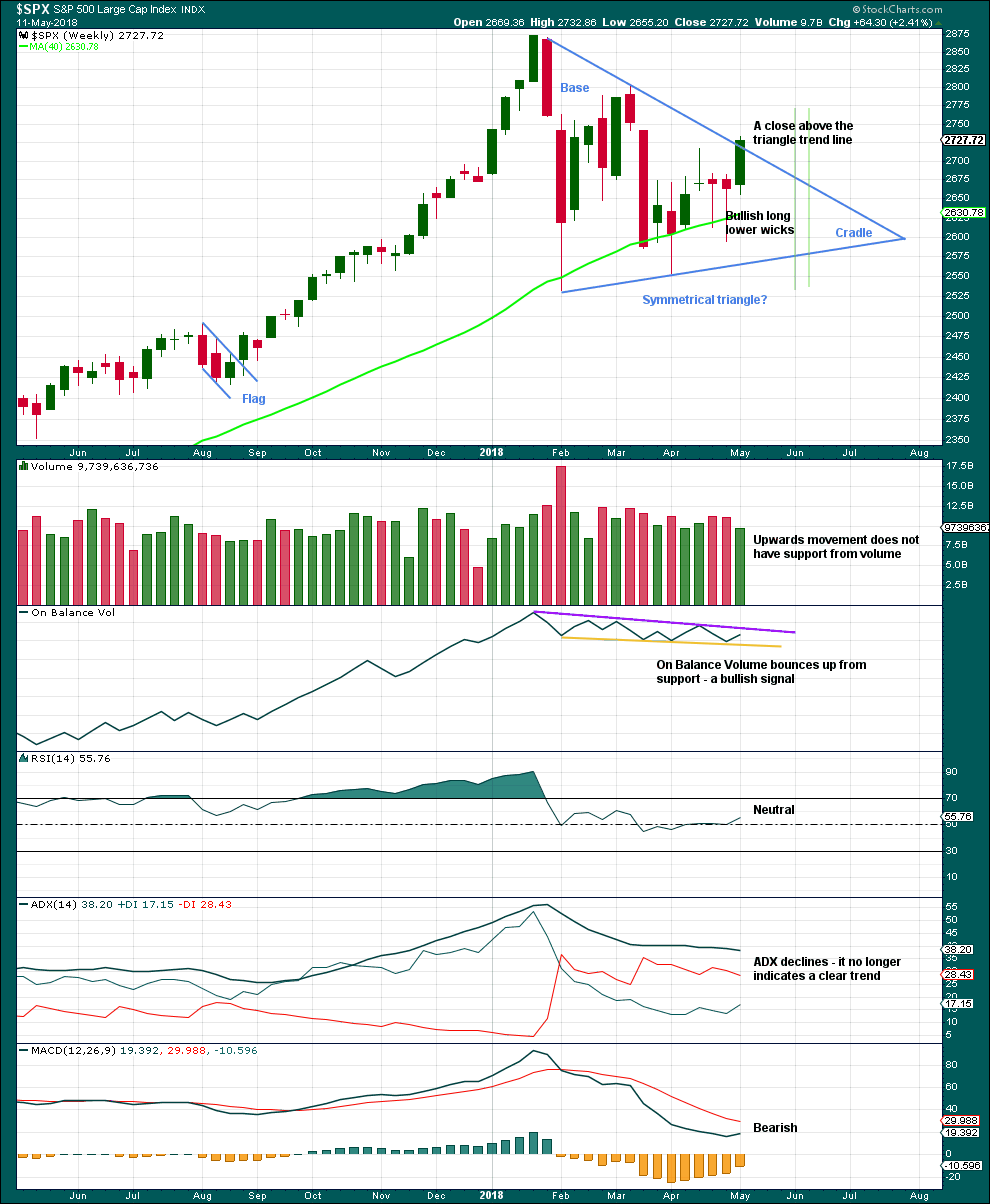
Click chart to enlarge. Chart courtesy of StockCharts.com.
A classic symmetrical triangle pattern may be forming. These are different to Elliott wave triangles. Symmetrical triangles may be either continuation or reversal patterns, while Elliott wave triangles are always continuation patterns and have stricter rules.
The vertical green lines are 73% to 75% of the length of the triangle from cradle to base, where a breakout most commonly occurs.
From Dhalquist and Kirkpatrick on trading triangles:
“The ideal situation for trading triangles is a definite breakout, a high trading range within the triangle, an upward-sloping volume trend during the formation of the triangle, and especially a gap on the breakout.”
For this example, the breakout may have happened this week. There is a high trading range within the triangle, but volume is declining.
DAILY CHART
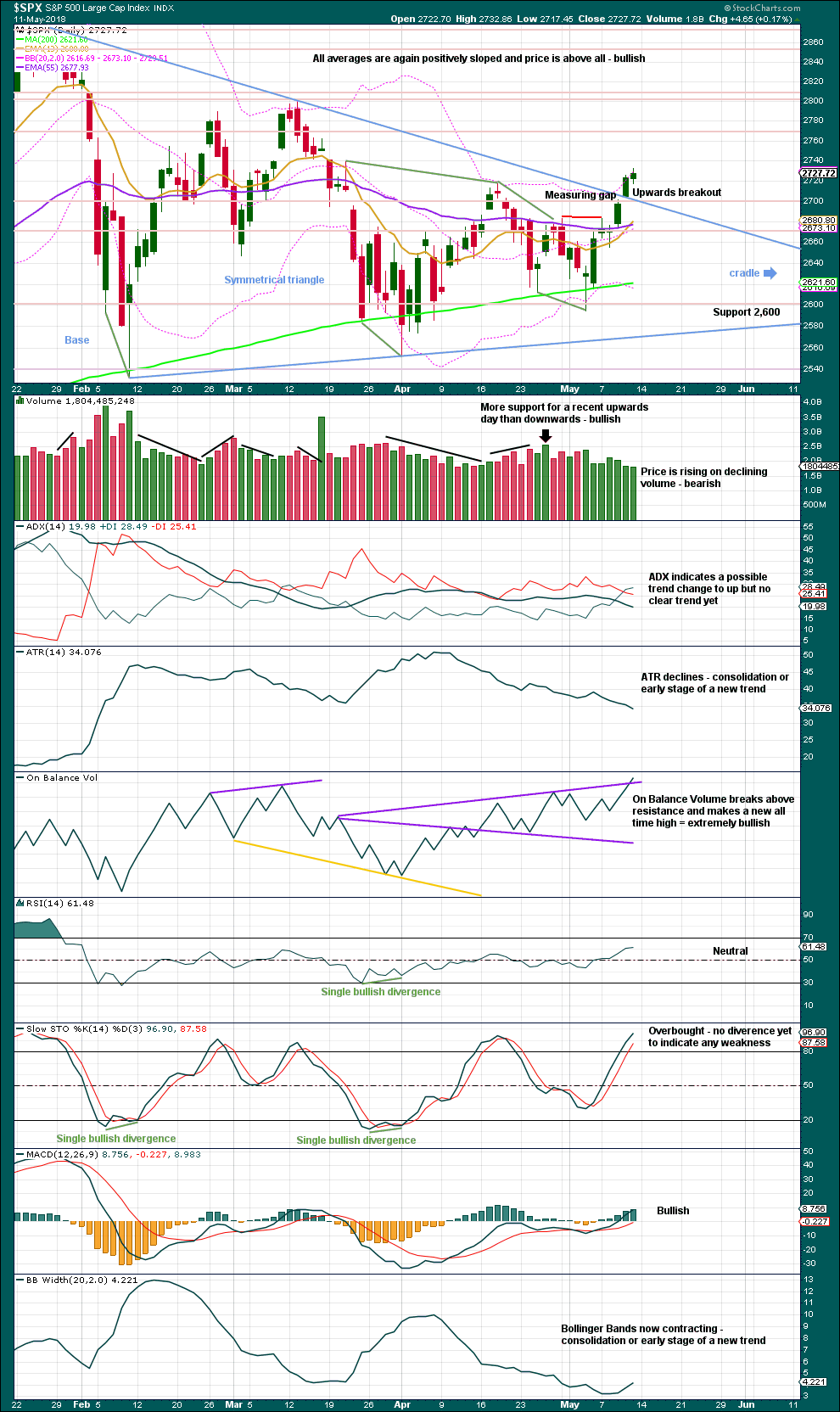
Click chart to enlarge. Chart courtesy of StockCharts.com.
The symmetrical triangle may now be complete, and now price has completed an upwards breakout. There may be some small cause for concern today that the upwards breakout does not have support from volume. However, in current market conditions only some small concern is had here. Rising price on light and declining volume has been a feature of this market for many months, yet price continues to rise.
After an upwards breakout, pullbacks occur 59% of the time. A pullback may find support at the upper triangle trend line and may be used as an opportunity to join a trend.
The base distance is 340.18. Added to the breakout point of 2,704.54 this gives a target at 3,044.72. This is above the Elliott wave target at 2,922, so the Elliott wave target may be inadequate.
For the short term, the next smaller consolidation or pullback may come about 2,811. This shorter term target is calculated using the measuring gap. That gap may now provide support and may be used to pull up stops on long positions.
On Balance Volume has made a new all time high, providing a very strong bullish signal; expect price to follow.
VOLATILITY – INVERTED VIX CHART
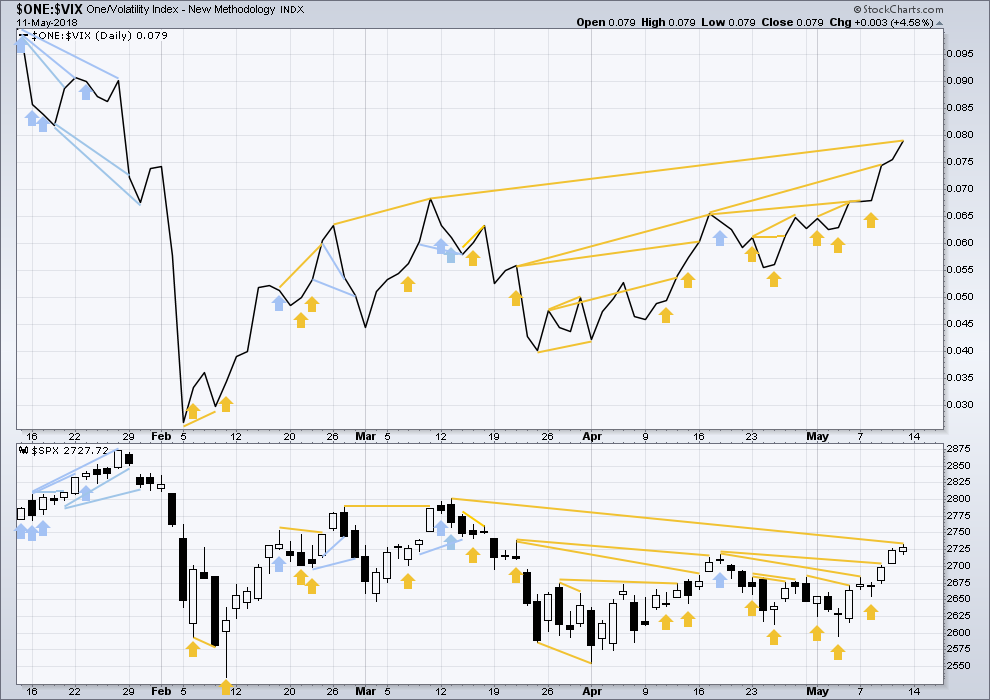
Click chart to enlarge. Chart courtesy of StockCharts.com.
So that colour blind members are included, bearish signals will be noted with blue and bullish signals with yellow.
Normally, volatility should decline as price moves higher and increase as price moves lower. This means that normally inverted VIX should move in the same direction as price.
There is still a cluster of bullish signals on inverted VIX. Overall, this may offer support to the main Elliott wave count.
Inverted VIX today is again much higher than the prior swing high of the 9th / 13th March, but price is not yet. Reading VIX as a leading indicator, this divergence is bullish.
BREADTH – AD LINE
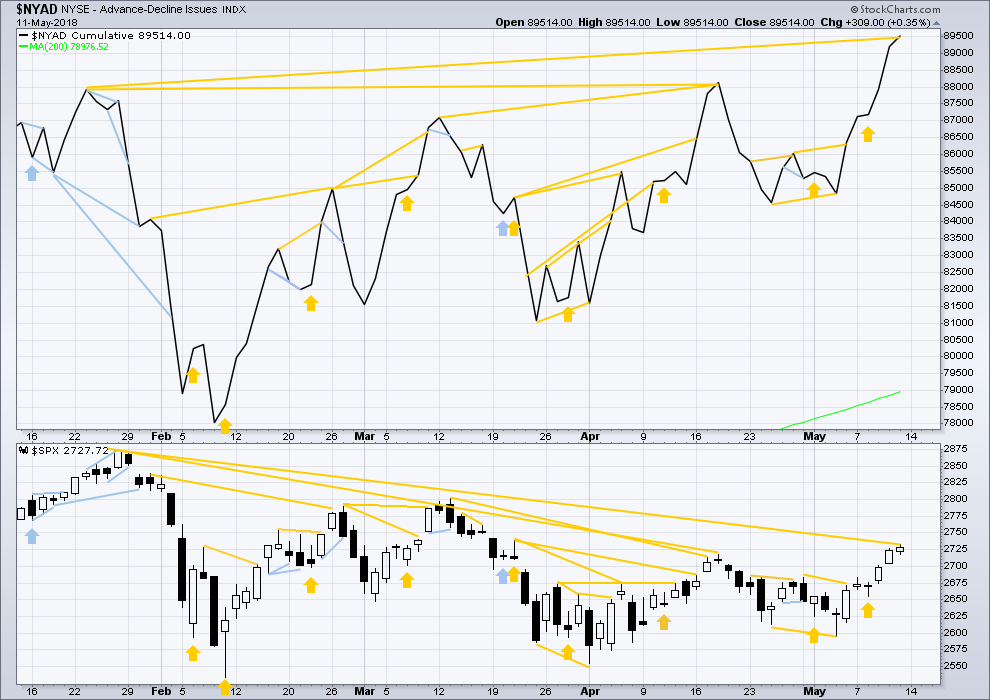
Click chart to enlarge. Chart courtesy of StockCharts.com.
There is normally 4-6 months divergence between price and market breadth prior to a full fledged bear market. This has been so for all major bear markets within the last 90 odd years. With no longer term divergence yet at this point, any decline in price should be expected to be a pullback within an ongoing bull market and not necessarily the start of a bear market. New all time highs from the AD line this week means that any bear market may now be an absolute minimum of 4 months away. It may of course be a lot longer than that. My next expectation for the end of this bull market may now be October 2019.
Small caps have made a new all time high this week, but mid and large caps have yet to do so. This divergence may be interpreted as bullish. Small caps may now be leading the market.
Breadth should be read as a leading indicator.
There has been a cluster of bullish signals from the AD line in the last few weeks. This also overall offers good support to the main Elliott wave count.
The AD line has made another new all time high today. This is a very strong bullish signal, and is one reason today why the more bearish Elliott wave counts are discarded. It is extremely likely now that price shall follow with a new all time high.
DOW THEORY
The following lows need to be exceeded for Dow Theory to confirm the end of the bull market and a change to a bear market:
DJIA: 23,360.29.
DJT: 9,806.79.
S&P500: 2,532.69.
Nasdaq: 6,630.67.
At this stage, only DJIA has made a new major swing low. DJT also needs to make a new major swing low for Dow Theory to indicate a switch from a bull market to a bear market. For an extended Dow Theory, which includes the S&P500 and Nasdaq, these two markets also need to make new major swing lows.
Charts showing each prior major swing low used for Dow Theory may be seen at the end of this analysis here.
Published @ 06:40 p.m. EST on 12th May, 2018.

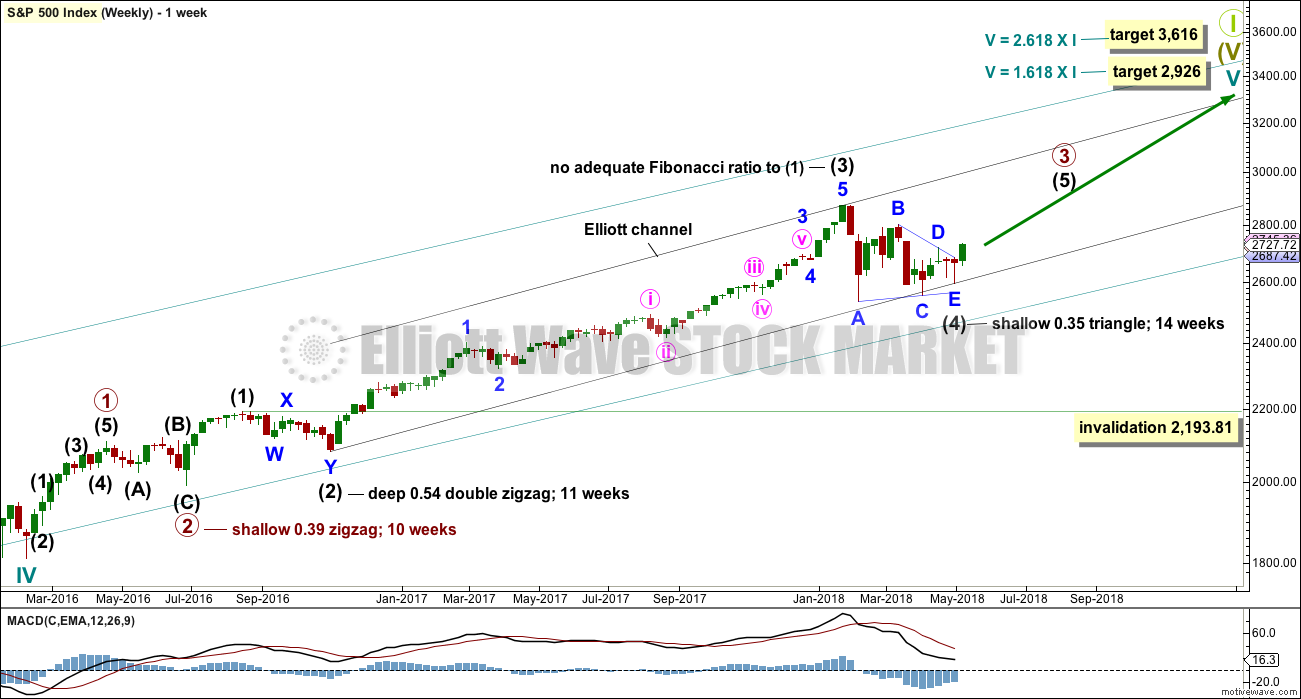
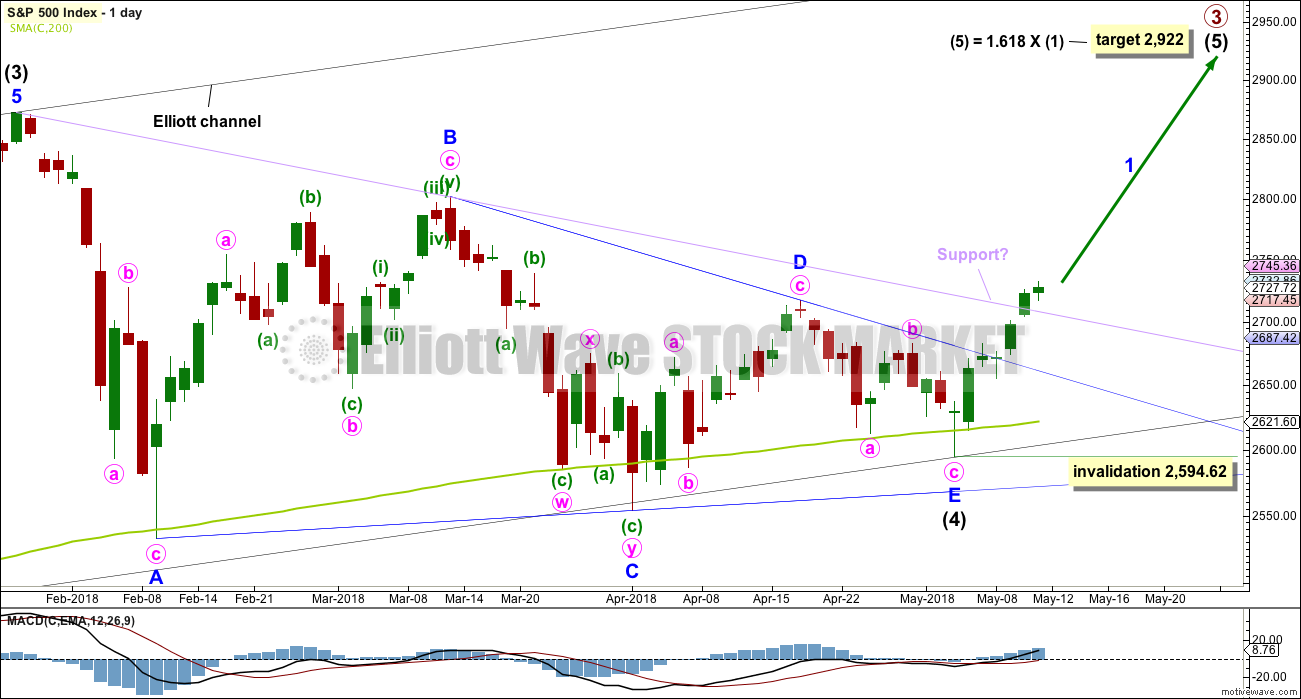
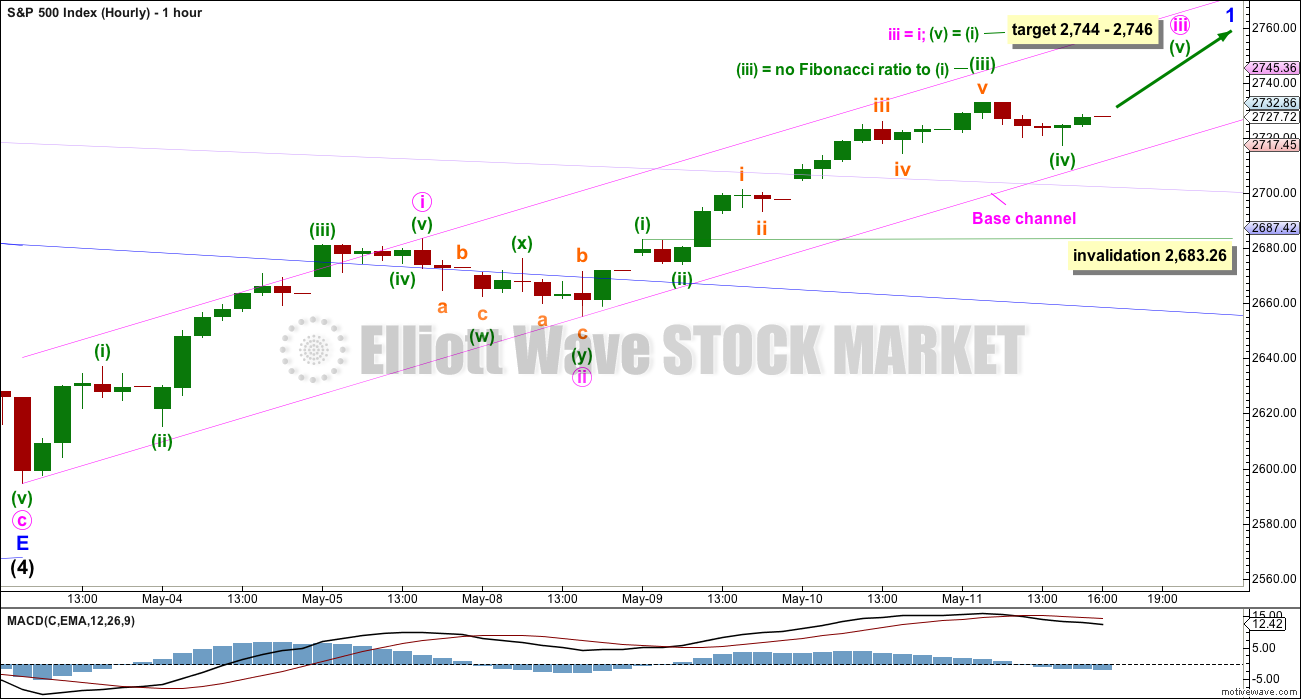
Hourly chart updated:
Minute iii may be over, minute iv may be either over or about halfway done.
Redraw the channel now using Elliott’s first technique. Look for support at the lower edge.
Thx Lara
Thx Lara.
Is the combination alternate still a possibility?
Technically it’s possible.
I think of it kinda like it’s possible we may see a colony on Mars in my lifetime. Possible… but extremely unlikely.
That’s how much weight I put on the AD line and On Balance Volume making new all time highs. Those highs strongly point to price also making new all time highs, and very unlikely to right after have an immediate and deep pullback to new lows.
Now, of course, I could be wrong. That is also entirely possible. I have been wrong before and will be wrong again.
I’m going here with the balance of probability. And the probability of that combination in my judgement and experience is so low, it should be discarded.
SPX turned on top of the 61.8% retrace of the last swing up. Has come up and touched the downtrend line it’s established today. If it breaks that line to the upside, I’m suspecting this minute 4 (if that’s what it is) was very short. But it’s never over until it’s over, and unlike baseball, we in EW land are rarely certain it’s over, only…suspicious!
Short, shallow pullbacks lately. I’ve been long for a few days now. Just added more, with a tight stop.
New position whip-sawed out almost immediately. Minute 4 might not be complete yet. Longer-held position still good and guaranteed profitable.
Kevin, do u keep a count on rut , ndx…? If so, do you mind sharing it jules97219@mail.com
Thx
Sure Jules, I’m refreshing now and will post in Lara’s update tonight.
There is an open gap on SPX from March 16-17 on the daily chart. It is roughly 2741 to 2749. I look for it to provide some resistance.
Price should come back to the zone of the prior 4, so 2717-2732, before bottoming and starting the minute 5. The corresponding minute 2 was 8 hours (love those fibo #’s!). This one’s at 3 and counting. Price “should” be falling here over the rest of the day, or this view is inaccurate and the minute 3 up is continuing further. For me, adding to evidence that the minute 4 is starting, is the fact that SPX price bounced off BOTH a major 62% and a 78%. Bam.
This could get right down and retest the TA top triangle line. Which would be “classic”. Suffice to say I’ll buy a little on an approach, touch and turn!!! Maybe even more than a little.
Yes sir! I hope it materializes.
TLT (20 year bonds) falling pretty hard this morning; I think that should be the impetus to slow this rally and start up the little 4 that’s due. SPX and NDX have tagged or sitting on/around 78% retracements. If they keep pushing up here, extremely bullish short term, but a turn down should probably be the start of the minute 4.
Also interesting the market is up modestly with VIX also up about 2% so far
Option traders anticipating the approaching minute 4! They know what’s up.
My SPX daily view going into tomorrow.
Old habits die hard. I am a scalper by nature, and use that method almost exclusively in my short term trading account. Allthough the scalp is generally the safe trade, it is not always necessarily the smart trade. The challenge is how to remain disciplined about profit targets without leaving a lot of money on the table. I was a subscriber to Lara’s work for several years before I started to notice I was leaving an awful lot of money on the table. The reason was that I was not paying enough attention to her price targets. I did better this week holding on through some whipsaw on Wednesday but still sold my SPY 266 calls too early. I left 25% on the table! If you don’t want to leave a lot of money on the table, be sure to pay attention to price targets.
Deploying very fat SPY 274/275 bear call credit spread on Monday, May 25 exipiration…
you know the drill.
Hope everyone has a wonderful weekend.
We’re celebrating Anna’s graduation from U of I! 🙂
Congratulations to Anna and to you and her mother. What a wonderful Mother’s Day celebration.
And Lara, you too are a mother so Happy Mother’s Day to you as well.
I am looking forward to a profitable month of May and summer.
Blessings to all on your week ahead.
Thanks Rod! She gets a shiny new sea-blue Honda Civic for her efforts but keep it quiet, we have not told her yet… 😉
BTW Rod, if you have not yet read Nomi Prins new book ‘Collusion”, it is well worth the time investment. It affected the allocation of my long term account quite a bit.
Thanks Rodney and Verne!
I had a lovely Mothers day. My teenage son gave me a “thank you” card. He said that a “sympathy” card may also have been appropriate.
He’s a bit of a smart a$$